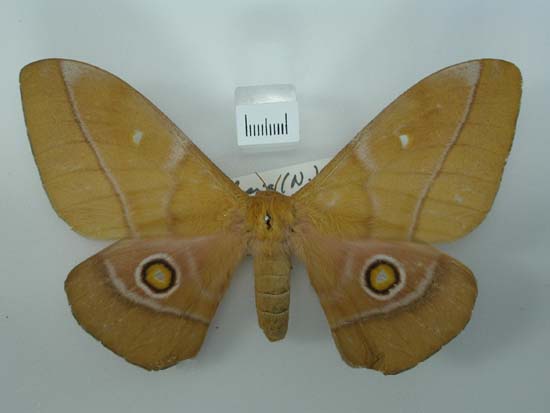Gonimbrasia gueinzii
|
|
Updated as per Pinhey's Emperor Moths of South and South-Central Africa, 1972, January 14, 2006
Updated as per Bouyer's Catalogue of African Saturniidae, 1999, January 14, 2006
Updated as per Cooper's The Emperor Moths of KwaZulu-Natal, 2002, January 14, 2006
|
Gonimbrasia (Nudaurelia) gueinzii
nood-aur-REEL-ee-uhmGWEEN-zee-eye
(Staudinger, 1872)
(Antheraea)

Gonimbrasia gueinzii courtesy of Frans Desmet,
Royal Museum for Central Africa,
Tervuren, Belgium
This site has been created by
Bill Oehlke at oehlkew@islandtelecom.com
Comments, suggestions and/or additional information are welcomed by Bill.
| TAXONOMY:
Superfamily: Bombycoidea, Latreille, 1802
Family: Saturniidae, Boisduval, [1837] 1834
Subfamily: Saturniinae, Boisduval, [1837] 1834
Tribe: Bunaeini, Packard, 1902
Genus: Imbrasia, Hubner, [1819] 1816 or
Genus: Nudaurelia Rothschild, 1895
|
MIDI MUSIC
Wind Beneath My Wings
copyright C. Odenkirk
MIDI CITY
ON.OFF
<bgsound src="wings.mid" LOOP=FOREVER>
|
DISTRIBUTION:
The Natal Emperor,
Gonimbrasia gueinzii (wingspan: 110-130mm), flies in
South Africa.
It is grouped with Imbrasia in many classifications.
Cooper and Cooper propose placing it in genus
Parabunaeopsis Bouvier, 1926. They also indicate it is endemic
to South Africa and specimens reported from other locales are
probably reducta, flavescens or cleoris.
Bouyer, on the other hand, equates flavescens with dione,
indicates cleoris is a brown subspecies of nyassana
from the mountains north of Lake Malawi, and he does not cover
reducta.
The specimen at the top of the page from the
Royal Museum for Central Africa does not have the straight outer
margin drawn by Cooper.
Much work still has to be done with the African Saturniidae.
FLIGHT TIMES AND LARVAL HOSTS:
The species is probably bivoltine with flights in
South Africa in January-February and August-November in habitats with
elevations from 300-900m.
Gonimbrasia gueinzii larvae feed upon Maesa alnifolia,
Maesa lanceolata, Myrica, Pyrus malus and Prunus.
ECLOSION, SCENTING AND MATING:
Both sexes are active at
night. Males come in to lights around midnight when females are
scenting.
EGGS, LARVAE, COCOONS AND PUPAE:
Off-white eggs are deposited in clusters of up to 40.
Incubation may last as long as twenty days.
Mature larvae, up to 90mm long, are black with red spiracles and a
very generous speckling of yellow dots. Scoli are equipped with
spines.
Pupation is in the soil in a subterranean chamber.
Larval Food Plants
It is hoped that this alphabetical
listing followed by the common name of the foodplant will prove useful.
The list is not exhaustive. Experimenting with closely
related foodplants is worthwhile.
Bersama abyssinica.......
Cajanus cajan
Combretum
Cotoneaster
Croton macrostachyus
Cupressus lusitanica
Eriosema
Eucalyptus camaldulensis......
Eucalyptus cladocalyx
Eucalyptus diversicolor
Eucalyptus drepanophylla.......
Eucalyptus melliodora
Eucalyptus paniculata
Eucalyptus saligna
Euclea
Khaya grandifoliola
Maesa alnifolia
Maesa lanceolata
Myrica
Pinus patula
Pyrus malus
Prunus
Prunus cerasus
Prunus serotina
Pseudarthria
Rosa
Rubus
Schinus molle
|
Bersama abyssinica
Pigeonpea
Chameleon vine
Cotoneaster
Broad-leaved croton
Mexican cypress
Eriosema
Redgum eucalyptus
Dwarf Sugar gum
Karri
Grey Ironbark
Yellow box
Grey Ironbark
Sydney Blue
Gum
Euclea
African mahogany
Maesa
False Assegaai
Bayberry
Patula Pine
Apple
Cherry
Dwarf Cherry/Sour Cherry/Morello Cherry
Wild Black Cherry
Pseudarthria
Rose
Blackberry/Raspberry
Brazilian pepper tree
|
Use your browser "Back" button to return to the previous page.
Return to the Nudaurelia Genus.
Goto African Saturniidae Index
Goto Main Saturniidae Index
The pronunciation of scientific names is
troublesome for many. The "suggestion" at the top of the page is
merely a suggestion. It is based on commonly
accepted English pronunciation of Greek names and/or some
fairly well accepted "rules" for latinized scientific names.
The suggested pronunciations, on this page and on other pages,
are primarily put forward to assist those who hear with internal
ears as they read.
There are many collectors from different countries whose
intonations and accents would be different.
Some of the early describers/namers chose genus
and species names indicating some character of the insect, but more
often, they simply chose names from Greek or Roman mythology or
history.Those species names which end in "ensis" indicate a
specimen locale, and those which end in "i", pronounced "eye", honour
a contempory friend/collector/etc.
The genus name Nudaurelia
means 'naked gold' (Pinhey).
The species name "gueinzii", is honourific for
William Gueinzius, a collector of the mid 1800's. (Pinhey).

Nudaurelia gueinzii male, on my home computer only, Cooper and Cooper.

Nudaurelia gueinzii larva, on my home computer only, Cooper and Cooper.


